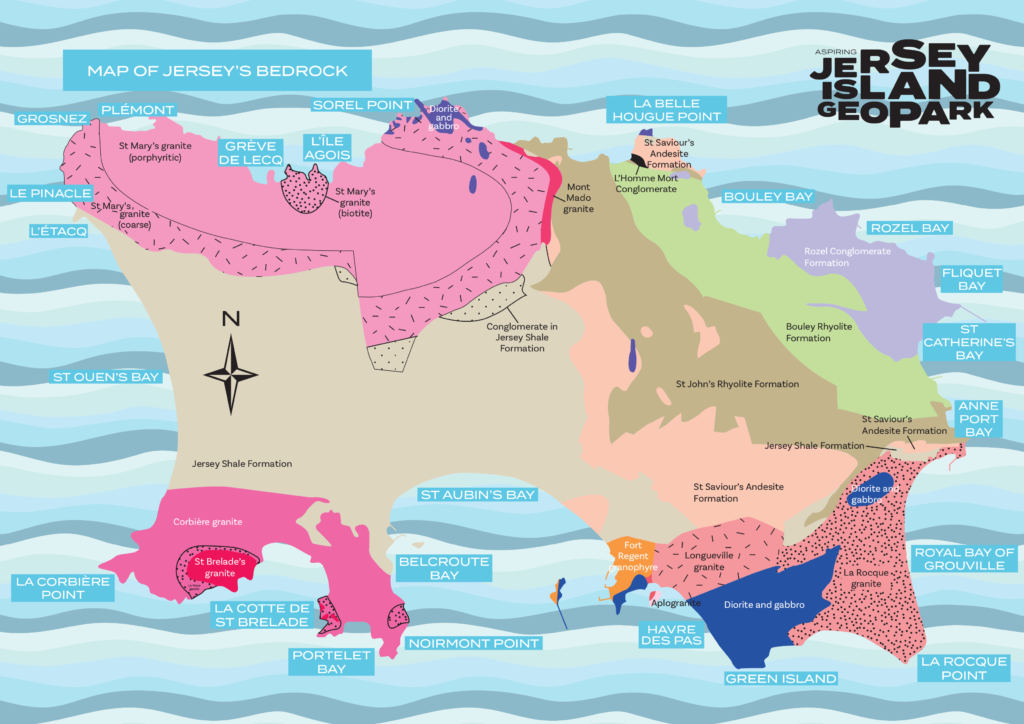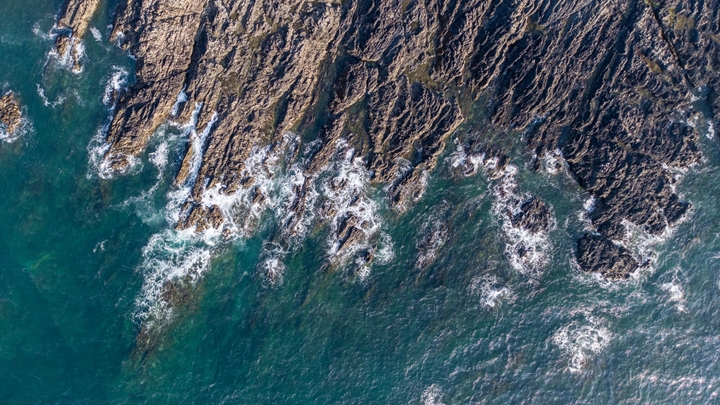
“UNESCO Global Geoparks are single, unified geographical areas where sites of intranational geological significance are managed with a holistic concept of protection, education and sustainable development”. There are 169 of there geoparks in 44 countries around the world. They carry geological heritage, tell us about the history, events and processes that formed it.

MINERALS OF JERSEY
Minerals are made from elements like silicon, oxygen, aluminium, iron and other metals. They are the fundamental building blocks of all rocks. As magma (molten rock) cools, minerals such as quartz and feldspar form crystals. The longer the cooling process takes, the larger the crystals. Minerals can also be carried through rocks by water, forming crystals as the water evaporates.
JERSEY SHALE FORMATION
The shales are the oldest rocks in the Island. You can see them in the west, across the centre and in the south of Jersey. They were formed by mud, silt and sand brought together on the sea floor about 600 million years ago. These sediments were transformed into rock by being pushed together, hardened and folded.
JERSEY VOLCANICS
Volcanic lavas and ashes can be seen along the north and northeast coasts of the Island. These andesites and rhyolites formed as a result of volcanic eruptions occurring 580 million years ago.
JERSEY GRANITES
Jersey is famous for its granites, which have been favoured as a building material for thousands of years. These major intrusive or ‘plutonic’ rocks were formed between 580 and 480 million years ago by molten rock cooling and solidifying between the Earth’s surface. They are only visible once the overlying rocks have been eroded away. The dark rocks known as gabbros are the oldest, and are rich in iron and magnesium. The true granites, visible along the northwest and southwest coasts, are lighter in colour, and consist of three main minerals: quartz, feldspar and mica. On the southeast coast, where granites have broken through the Earth’s surface into older gabbros, a mixed rock called diorite has formed.
ROZEL CONGLOMERATE
Formation Conglomerate can be seen along the northeast of the Island and is made up of beds of pebbles which have been cemented together. They were formed around 400 million years ago and are the youngest hard rock formation in Jersey. Conglomerate is also known as ‘pudding stone’ because the rock formation is made up of lots of pebbles, probably from eroded and worn mountains. Streams with fast flowing water carried the pebbles and sand down valleys and left them behind before they cemented together.
JERSEY’S OFFSHORE REEFS
Jersey is surrounded by offshore reefs bursting with marine life, Les Pierres de Lecq to the north, Les Écréhous to the northeast and Les Minquiers to the south. Local fisherman enjoy fishing around these reefs which often prove dangerous to larger ships.
HOW OLD IS THAT ROCK?
At low tide Les Minquiers reef is bigger than Jersey. On this large reef, the rock is mostly made up of types of granite. These granites have features older than the Jersey granites. Could this mean that Les Minquiers reef is older than Jersey?
SEA LEVELS AND CLIMATE CHANGE
The world’s climate fluctuates as a result of changes in the sun’s activity affecting the polar ice caps, the dome-shaped sheets of ice found in Greenland and Antarctica. These effects occur gradually over time, making sea levels change as ice caps melt or cool. This cycle of cold and warm periods has repeated itself several times over the past two million years. Since 10,000 years ago, sea levels have risen to make Jersey an Island once more.
GLACIAL
In a cold period, global temperature becomes cooler causing the ice caps to grow. This traps much of the world’s water, causing sea levels to drop as much as 200 metres. Just imagine the English Channel disappearing with Jersey and Guernsey as only hills in a vast coastal plain.
INTERGLACIAL
In a warm period, global temperature becomes warmer causing the ice caps to melt. Sea levels rise as freshwater is released back into the oceans. Evidence for past changes in sea level and the shifting of the Earth’s tectonic plates can be seen today in the many raised beaches in Jersey. The highest raised beach in the Island is at South Hill.
Jersey’s Geological Heritage – Sites of Special Interest (SSI)
Sites of special interest are places of zoological, ecological, botanical or geological significance. Jersey’s geology is very much different than that of the United Kingdom and other Chanel Islands. The States of Jersey has chosen 22 of the islands most important areas as Sites of Special Interest so that they can be protected from development for future research.

This booklet introduces you to Jersey’s geological SSI, covering information about their location and basic descriptions and photographs which highlights each site’s significance defining features.
Read the Aspiring Jersey Island Geopark prospectus

The Aspiring Jersey Island Geopark Visitor Centre presents the story of Jerseys geological heritage.
Geopark Ambassadors
Geopark Ambassadors represent some of the organisations working with Aspiring Jersey Island Geopark. One of the ambassadors is Ralph Nicolas, a Geologist Société Jersiaise Lecturer, Teacher, Secretary for the Geology, Archaeology and Jèrriais Sections of Société Jersiaise.

Each Ambassador tells us what makes Jersey such a remarkable place.





Hi Nathan, there are a number of blogposts from My ROCK project missing. Please make sure that you keep on trac with tasks so it doesn’t become too overwhelming. If you need an extra help and support please let us know. Maybe come into a few extra sessions per week in your study periods. The period after our photography lesson are free for you to work in the classroom.